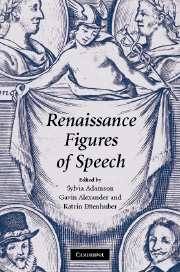Book contents
- Frontmatter
- Dedication
- Contents
- List of illustrations
- List of contributors
- Preface
- Note on spelling and references
- Introduction: the figures in Renaissance theory and practice
- Chapter 1
- Chapter 2
- Chapter 3
- Chapter 4
- Chapter 5
- Chapter 6
- Chapter 7
- Chapter 8
- Chapter 9
- Chapter 10
- Chapter 11
- Chapter 12
- Chapter 13
- Notes
- Suggestions for further reading
- Index
Introduction: the figures in Renaissance theory and practice
Published online by Cambridge University Press: 05 February 2014
- Frontmatter
- Dedication
- Contents
- List of illustrations
- List of contributors
- Preface
- Note on spelling and references
- Introduction: the figures in Renaissance theory and practice
- Chapter 1
- Chapter 2
- Chapter 3
- Chapter 4
- Chapter 5
- Chapter 6
- Chapter 7
- Chapter 8
- Chapter 9
- Chapter 10
- Chapter 11
- Chapter 12
- Chapter 13
- Notes
- Suggestions for further reading
- Index
Summary
The common scholemasters be wont in readynge, to saye unto their scholers: Hic est figura: and sometimes to ask them, Per quam figuram? But what profit is herein if they go no further?
Richard Sherry (1550)A figure is ever used to a purpose, either of beautie or of efficacie…
George Puttenham (1589)Critical sophistication in this period comes in the form of rhetorical analysis, but while we may be impressed by the technical acumen which can applaud a ‘pretty epanorthosis’, it is more difficult for us to feel the same kind of enthusiasm for such verbal effects.
Neil Rhodes (1992)The central concern of this volume is to provide a more complete account of the value and appeal of the figures of rhetoric to literary studies than has previously been available. Our method of enquiry takes the form of a set of case studies of specific figures, which, taken together, aim to elucidate the opinion of Puttenham and answer the scepticism represented by Rhodes. The role of this introduction is to provide a context for the case studies by setting the figures in their place in the larger rhetorical system and setting rhetoric in its place in Renaissance literate culture.
To ask questions about the role of the rhetorical figures in English Renaissance literature is to engage with a theoretical system that at first glance might not seem to fit at all.
Information
- Type
- Chapter
- Information
- Renaissance Figures of Speech , pp. 1 - 14Publisher: Cambridge University PressPrint publication year: 2007
